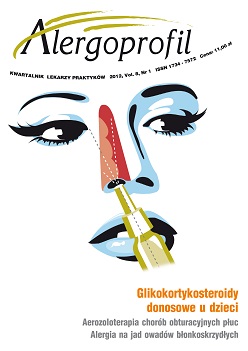Aerosol therapy in obstructive lung diseases
Main Article Content
Abstract
Inhalation therapy is a golden standard in treatment of various disorders of the respiratory system. It is the most important form of delivering active molecules to sites of disease activity, especially in inflammatory airway disorders. The easiness of delivering small particles to peripheral areas of the lungs allows treating various disorders not only in airways but also in the lung parenchyma. Delivery small particles of hormones (insulin) or opioids, to the periphery of the respiratory system allow treatment of diseases as diabetes and to control pain. The author describes the basics of aerosol therapy and the role of this form of drug delivery in obstructive lung disorders.
Downloads
Article Details
Copyright: © Medical Education sp. z o.o. This is an Open Access article distributed under the terms of the Attribution-NonCommercial 4.0 International (CC BY-NC 4.0). License (https://creativecommons.org/licenses/by-nc/4.0/), allowing third parties to copy and redistribute the material in any medium or format and to remix, transform, and build upon the material, provided the original work is properly cited and states its license.
Address reprint requests to: Medical Education, Marcin Kuźma (marcin.kuzma@mededu.pl)
References
2. Crompton G.K.: Problems patients have using pressurized aerosol inhalers. Eur. J. Respir. Dis. Suppl. 1982, 119: 101-4.
3. Molimard M., Raherison C., Lignot S., Depont F., Abouelfath A., Moore N.: Assessment of handling of inhaler devices in real life: an observational study in 3811 patients in primary care. J. Aerosol Med. 2003, 16(3): 249-54.
4. Pirożyński M.: Leczenie wziewne – charakterystyka różnych rodzajów inhalatorów. Post. Aerozoloterapii 2000, 8(1): 17-21.
5. Newman S., Peart J.: DryPowderInhalers. W: Respiratory Drug Delivery: Essential Theory and Practice. Newman S. (red.). Richmond, USA: RDD [online] 2009: 257-308.
6. Groneberg D.A., Witt C., Wagner U., Chung K.F., Fischer A.: Fundamentals of pulmonary drug delivery. Respir. Med. 2003, 97(4): 382-7.
7. Atkins P.J.: Dry powder inhalers: an overview. Respir. Care 2005, 50(10): 1304-12.
8. Baba K., Tanaka H., Nishimura M., Yokoe N., Takahashi D., Yagi T., Yamaguchi E., Maeda Y., Muto T., Hasegawa T.: Age-dependent deterioration of peak inspiratory flow with two kinds of dry powder corticosteroid inhalers (Diskus and Turbuhaler) and relationships with asthma control. J. Aerosol. Med. Pulm. Drug Deliv. 2011, 24(6): 293-301.
9. Doniec Z., Pirożyński M.: Turbuhaler, co mówią badania kliniczne. Post. Aerozoloterapii 1996, 4(3-4): 117-22.
10. Pirożyński M., Doniec Z.: Turbuhaler, co mówią badania kliniczne. Cz. II. Post. Aerozoloterapii 1997, 5(3-4): 145-58.
11. Fink J.B.: Aerosol device selection: evidence to practice. Respir. Care 2000, 45(7): 874-85.
12. Dolovich M.B., Ahrens R.C., Hess D.R., Anderson P., DhandR., Rau J.L., Smaldone G.C., Guyatt G.: Device selection and outcomes of aerosol therapy: Evidence-based guidelines: American College of Chest Physicians/American College of Asthma, Allergy, and Immunology. Chest 2005, 127(1): 335-71.
13. Dolovich M.B., Dhand R.: Aerosol drug delivery: developments in device design and clinical use. Lancet 2011, 377(9770): 1032-45.

